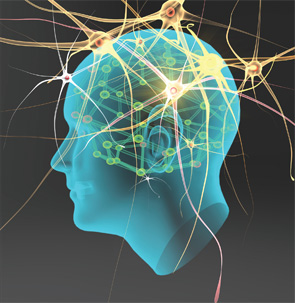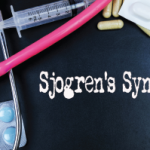
BOSTON—Rheumatologists who treat patients with Sjögren’s syndrome should watch for signs of central or peripheral nervous system complications and lymphomas. The first task is meticulous appraisal for any other clinical entities that may cause a neurological syndrome, especially important for patients on immunosuppressive medications.
“We need to be ruthlessly paranoid that we might be overlooking the spectrum of infection in these patients,” said neurologist and rheumatologist Julius Birnbaum, MD, MHS, associate director of the Johns Hopkins Jerome L. Greene Sjögren’s Syndrome Center in Baltimore. Dr. Birnbaum and an expert on lymphoma risk in Sjögren’s both offered tips for rheumatologists to screen and treat patients in the session, Clinical Challenges of Sjögren’s Syndrome: Neurological Complications and Lymphoma Risk, at the ACR/ARHP Annual Meeting in Boston on Nov. 17, 2014.
Use VITAMIN
Use the VITAMIN mnemonic to help determine a differential diagnosis of central nervous system (CNS) complications in Sjögren’s, Dr. Birnbaum said. Rule out vascular causes or strokes, infections, trauma, other autoimmunity, metabolic disorders, iatrogenic complications or neoplastic causes.
“Always suspect … a neurological disorder in Sjögren’s syndrome patients … is due to a competing comorbidity,” Dr. Birnbaum said.
Diffuse CNS complications may present with similar frequency in Sjögren’s patients and healthy controls, Dr. Birnbaum said. This suggests that Sjögren’s syndrome is not the primary cause and has important therapeutic ramifications.
“Sjögren’s patients presenting with diffuse syndromes of headache, affective disorders or focal disorders like stroke or seizures can essentially be managed as if the patient did not have Sjögren’s,” and not all of them need to go on immunosuppressant therapy, he said.
Unlike patients with systemic lupus erythematosus, most Sjögren’s patients do not have a primary vasculopathy as the cause of their CNS syndromes, Dr. Birnbaum said. Only 10% test positive for antiphospholipid antibodies. There is only mild evidence for CNS endothelial activation, arterial stiffness and accelerated atherosclerosis in Sjögren’s patients, he said. Cognitive impairment affects about 60% of these patients.
“The metaphor of brain fog is actually a very incisive one for this group,” he said. Cognitive impairment is likely not progressive and may be associated with modifiable pain and fatigue. Aggressively screening for such potentially modifiable risk factors may improve the perception of brain fog in Sjögren’s patients, he said.
Assess Lesions
In most cases, white matter lesions on brain neuroimaging studies do not indicate the presence of a demyelinating syndrome, so don’t order magnetic resonance imaging (MRI) based on vague symptoms, Dr. Birnbaum said. Clinical evidence of optic neuritis, myelitis, brainstem syndrome or cerebellar syndrome is required first. “You have to have an attack, it has to be referable to the central nervous system, and it has to last at least 24 hours,” he said. “We should not be ordering routine MRI neuroimaging on Sjögren’s syndrome patients who present with diffuse symptoms,” such as headaches, he said.
Lesions may not point to multiple sclerosis (MS), and in fact, most brain lesions in Sjögren’s patients have different radiographic features than those associated with MS, said Dr. Birnbaum. “MS is very low on the differential diagnosis of white matter lesions in Sjögren’s syndrome patients,” he said. For example, MS scans may show Dawson’s fingers, which radiate outward from the ventricular surface, and prominent periventricular lesions. Brain lesions in Sjögren’s patients rarely show Dawson’s fingers and occur in a pattern with periventricular sparing lesions. In addition, inflammatory myelopathies may occur in Sjögren’s patients without brain lesions, he added.
Another possible demyelinating syndrome that can be distinguished from MS in Sjögren’s patients is Devic’s syndrome, or neuromyelitis optica (NMO). Spinal-cord lesions in NMO are considered a longitudinally extensive myelitis, due to the presence of inflammatory spinal-cord lesions spanning at least three vertebral segments on MRI studies, Dr. Birnbaum said. NMO-IgG antibody is a disease biomarker for this condition and targets aquaporin-4, which is the primary water-pump channel protein in the CNS. However, aquaporin-4 is also expressed in the salivary glands, lungs and kidneys, organs that are targeted in Sjögren’s syndrome patients.
“Sjögren’s patients may have a unique immunological predilection to develop these antibodies,” he said. The only unequivocal time to order immunosuppressant therapy in Sjögren’s syndrome with CNS manifestations is when a patient has Devic’s or another demyelinating syndrome other than MS, such as transverse myelitis, he said.
Other Neuropathies
Peripheral neuropathies are associated with specific antibody profiles in Sjögren’s syndrome, Dr. Birnbaum said. Whereas vasculitic neuropathies are associated with anti-Ro/SS-A antibodies and markers of B-cell activation, painful sensory neuropathies with normal electrodiagnostic studies may have lower frequencies of B-cell activation markers.
Neuropathic pain may be seen in about 20% of Sjögren’s patients, although only about 5–10% of patients in the literature show evidence of neuropathies. This disparity may be due to under-recognition of small-fiber neuropathies, painful conditions primarily affecting unmyelinated nerve fibers that require skin biopsy to diagnose, Dr. Birnbaum said. Patients with small-fiber neuropathies may complain of intense burning and allodynic pain. Two phenotypically distinct patterns of small-fiber neuropathy exist and can be distinguished based on the pattern of pain. Length-dependent, small-fiber neuropathies cause distal pain affecting the feet and distal extremities, and non-length-dependent, small-fiber neuropathies cause multifocal and diffuse burning pain, he said. A skin punch biopsy is not only a diagnostic biomarker of small-fiber neuropathies, but can help define these two patterns. In both subtypes of small-fiber neuropathies, aggressive symptomatic treatment of neuropathic pain is crucial, he said.
Vasculitic neuropathies are invariably painful and always require immunosuppressant therapy, Dr. Birnbaum said. Axonal neuropathies may not always be painful and may only have subclinical symptoms or mild weakness. Although symptomatic therapy is indicated in both axonal and vasculitic neuropathies, immunosuppressive therapy is always warranted for vasculitic neuropathies, and symptomatic treatment may be sufficient for axonal neuropathies, he said.
Lymphoma Risk
Lymphoma is only seen in 5–10% of primary Sjögren’s syndrome patients, said Elka Theander, PhD, associate professor of internal medicine at Lund University and Skane University Hospital in Malmö, Sweden. About a third of those malignancies are non-Hodgkin’s lymphomas, and may occur at a median of 11 years after the Sjögren’s diagnosis, she said.
“What you could tell your patient is that there is a risk of lymphoma, but it won’t be just now. It’s usually a later event,” said Dr. Theander. “Your patient may follow with, ‘Are there some obvious signs that I should look for?’” They should watch for swollen lymph nodes, heavy night sweats, temperatures that come and go without obvious causes, losing more than 10% of body weight, or new, persistent salivary gland swelling or change in shape, she said.
‘Always suspect … a neurological disorder in Sjögren’s syndrome … is due to a competing comorbidity.’
—Julius Birnbaum, MD, MHS
Don’t wait until Sjögren’s patients present with these symptoms, Dr. Theander said. “In rheumatology, I think we need to find predicting signs, like biomarkers, to [identify] patients in an early, prelymphoma situation. It’s very important to look into the future and understand which of our patients, in five or 10 years, are among those who may be lymphoma patients, and then tailor an approach,” Dr. Theander said. Strong signs of lymphoma risk include persistent parotid gland swelling, low C4 palpable purpura, cryoglobulinemia and hypocomplementemia, she said.
About 60–80% of lymphomas in Sjögren’s syndrome are mucosal-associated lymphoid tissue malignancies or MALTs, as opposed to diffuse large B-cell lymphomas or DLBCLs, Dr. Theander said. MALTs may be seen significantly earlier after diagnosis and in younger patients, she said. “More than 70% of patients with MALTs have hypergammaglobulinemia at their primary Sjogren’s syndrome diagnosis,” she said. Extraglandular manifestations are more often seen in DLBCL patients.
Germinal center-like structures are a risk factor for lymphoma in Sjögren’s syndrome, Dr. Theander said. These are an important place for B-cell maturation. Patients may present with terrible vasculitis. Increasing focal scores of three or greater are a good predictor of germinal center-like structures and lymphoma, she said.
Salivary gland biopsy may also help identify patients at higher lymphoma risk. “These patients also have a number of upregulated genes in their salivary glands,” she said. Repeated biopsies for longitudinal assessment are not practical. “We need other methods of repeated lymphoma risk evaluation,” she said.
Measure disease activity scores with serology and ultrasound of the salivary glands, and add biopsy if needed, she said. Men may be at higher risk for lymphomas in Sjögren’s syndrome, she added. Look for family history of malignancy, as well.
Rituximab and abatacept may reduce glandular swelling and reduce germinal center formation in Sjögren’s syndrome, so these agents may one day help prevent lymphoma in these patients, Dr. Theander said.
In high-risk patients, rheumatologists should do regular follow-ups to assess for lymphoma and consider early disease-modifying treatment in patients with symptomatic, systemic disease activity, she said.
“I have no answer, but my feeling is that soon it will be time to take Sjögren’s syndrome more seriously and to start treatment earlier,” she said.
Susan Bernstein is a freelance medical journalist based in Atlanta.
Second Chance
If you missed this session, Clinical Challenges of Sjögren’s Syndrome: Neurological Complications and Lymphoma Risk, it’s not too late. Catch it on SessionSelect.

